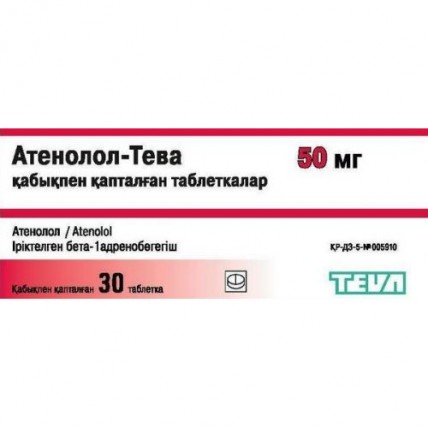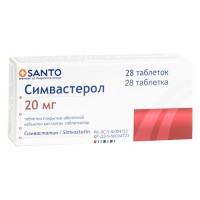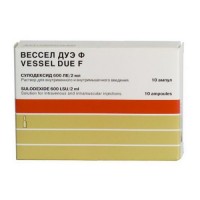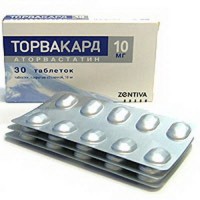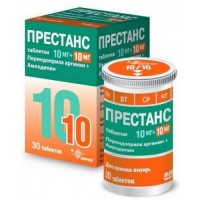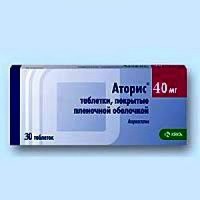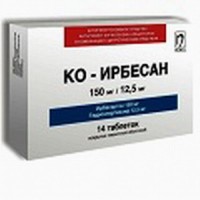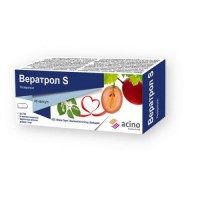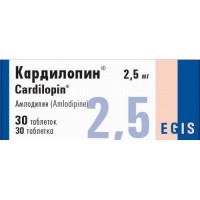Atenolol-Teva 30s 50 mg coated tablets
- $4.70
The instruction for medical use of medicine of Atenolol-Tev the Trade name of Atenolol-Tev the International unlicensed name Atenolol Dosage Form of the Tablet, coated, 25 mg, 50 mg Structure One tablet soderzhitaktivny substance – atenolol of 25 mg or 50 mg, excipients - cellulose microcrystalline, starch corn, magnesium a carbonate, sodium lauryl sulfate, magnesium stearate, gelatin, structure of a cover: hydroksipropilmetiltsellyuloza, titan dioxide (E 171), glycerin. The description of the Tablet, film coated white color, round shape, with a biconvex surface, with risky on one party (for a dosage of 25 mg). Tablets, film coated white color, round shape, with a biconvex surface, with the risky and squeezed-out inscription M 006 on one party (for a dosage of 50 mg). Pharmacotherapeutic group Drugs for treatment of cardiovascular diseases. Selection beta blockers. Atenolol. The ATX C07AB03 code the Pharmacological Pharmacokinetics Later properties of oral use atenolol approximately for 50% is soaked up from digestive tract. System availability makes about 50%. The maximum level in plasma is reached in 2-4 hours. About 90% of atenolol within 48 hours in not changed look are removed through kidneys. Time of semi-removal of atenolol is at normal function of kidneys of 6-10 hours. In a terminal renal failure time of semi-removal can increase till 140 o'clock. Atenolol-Tev's pharmacodynamics of 25 mg, 50 mg is selection beta1-adrenoblocker, affects mainly heart beta1-adrenoceptors ('a cardioselective beta-blocker') without internal sympathomimetic activity and without membrane stabilizing action. Atenolol-Teva possesses anti-anginal, hypotensive and antiarrhytmic action. Atenolol reduces automatism of sinus node, urezhat heart rate, slows down atrioventricular conductivity, reduces contractility and excitability of a myocardium, warm emission, reduces the need of a myocardium for oxygen. Indications of Atenolol-Tev of 25 mg: - functional cardiovascular disturbances (hyperkinetic cardial syndrome, functional disturbances of regulation of arterial blood pressure) of Atenolol-Tev of 50 mg: - arterial hypertension - stenocardia - disturbances of a warm rhythm: sinus tachycardia, prevention of supraventricular tachyarrhythmias, a ciliary tachyarrhythmia, an atrial flutter the Route of administration and a dosage of the Dose of drug of Atenolol-Tev of 25 mg and duration of treatment are established by the attending physician individually depending on the gained therapeutic effect. Functional cardiovascular disturbances (hyperkinetic cardial syndrome, functional disturbances of regulation of arterial blood pressure) On 1 tablet of Atenolol-Tev 25 mg or ½ tablets of Atenolol-Tev of 50 mg Chronic stable and unstable stenocardia of 50-100 mg of atenolol a day (1-2 tablets of Atenolol-Tev of 50 mg). Arterial hypertension Treatment usually begin 50 mg of atenolol (1 tablet of Atenolol-Tev of 50 mg) with single use. If necessary the day dose in a week is increased to 100 mg (2 tablets of Atenolol-Tev of 50 mg). Supraventricular (supraventricular) and ventrikulyarny {ventricular) arrhythmias appoint Atenolol on 50 mg 1-2 times a day (1-2 tablets of Atenolol-Tev of 50 mg). Atenolol-Tev's reception 50 mg has to be immediately stopped in case of decrease in number of reductions of heart and/or arterial blood pressure or emergence of other complications. Renal failures If the clearance of creatinine (CC) is 10-30 ml/min., the dose of atenolol can be reduced twice from recommended. If KK makes less than 10 ml/min., the dose of atenolol can be reduced up to ¼ from recommended. Elderly patients the Dose decline is possible in connection with insufficiency of function of kidneys. Children Are not present experience of use of this drug for children. Atenolol-Teva 25 mg, 50 mg accept inside, without chewing, washing down with enough liquid (for example, water), before meal. Unexpected drug withdrawal or breaks in treatment can cause heart ischemia with exacerbation of stenocardia and arterial hypertension or even to provoke a myocardial infarction. Therefore drug withdrawal and lowering of a dose have to be made slowly, stupeneobrazno. Side effects In clinical trials it was reported about the following undesirable effects: very often (≥ 1/10), it is frequent (≥ 1/100 to & lt, 1/10), infrequently (≥ 1/1000 to & lt, 1/100), is rare (≥ 1/10000 to & lt, 1/1000), is very rare (& lt, 1/10000), including separate reports with an unknown frequency (frequency cannot be estimated on the available data). Disturbances from a cardiovascular system: Often - bradycardia, cold extremities Seldom - deterioration in heart failure, disturbance of atrioventricular conductivity, hypotonia (orthostatic hypotonia) which can cause a syncope, deterioration in symptoms in patients with peripheral vascular insufficiency (including in patients with the alternating lameness), Reynaud's syndrome. Disturbances from nervous system: In an initiation of treatment - dizziness, perspiration, change of mood, a sleep disorder, nightmares Seldom - hallucinations, psychoses, confusion of consciousness, nonsense, paresthesias, a headache, dizziness, depressive moods, nightmares from digestive tract: Often - an abdominal pain, nausea, vomiting, an abdominal distension, constipations, a diarrhea. Infrequently - increase in hepatic transaminases, an intra hepatic cholestasia, hepatitis from blood and lymphatic system: Seldom - a purpura, thrombocytopenia from skin and hypodermic fabrics: Seldom - allergic skin reactions (itching, erubescence, a dieback), a hair loss it is Very rare - psoriasis it is not known - allergic reactions in the form of a Quincke's edema from genitals and a mammary gland: Seldom - disturbances of a libido, impotence, a gynecomastia from respiratory organs: Seldom - dispnoe, at predisposed patients the emergence of a syndrome of bronchial obstruction from organs of sight is possible: Seldom - disorders of vision, reduction of secretion of a lacrimal gland that especially comes to light at the patients using contact lenses from endocrinology: - a demonstration of latent diabetes or weighting of a condition of patients with the current diabetes of Disturbance of lipidic exchange: - at the general cholesterol remaining within norm the level of lipoproteids of high density decreases and the level of triglycerides in plasma Frequency increases it is unknown a Lyupus-like syndrome, increase in antinuclear antibodies of the Contraindication - hypersensitivity to atenolol, other beta blockers or to other excipients - an acute heart failure - cardiogenic shock - atrioventricular block of II and III degree - a sick sinus syndrome - sinuatrial blockade - sinus bradycardia (pulse less than 50 blows in min. before an initiation of treatment) - arterial hypotonia (systolic pressure is less, than 90 mm Hg) - a metabolic acidosis - bronchial asthma - not treated pheochromocytoma - late stages of disturbance of peripheric circulation - a concomitant use of monoamine oxidase inhibitors (MAO) (an exception are MAO-B inhibitors) - simultaneous intravenous administration of blockers of calcium channels as verapamil and diltiazem, or other antiaritmik (for example, Disopyramidum). The exception is made by the patients who are in intensive care units. Medicinal interactions At simultaneous use of Atenolol-Tev of 25 mg, 50 mg and: - antihypertensive drugs, diuretics, vazodilatator, tricyclic antidepressants, barbiturates, fenotiazin the hypotensive effect of atenolol can amplify, - antiarrhytmic means – the hypotensive effect of atenolol increases, - blockers of calcium channels (type verapamil and diltiazem) or other antiaritmik (for example, Disopyramidum) arterial hypotension, bradycardia and other disturbances of a heart rhythm, heart failure can develop (patients have to be exposed to monitoring). Antagonists of calcium have to be appointed in 48 h after the termination of intake of atenolol, - blockers of calcium channels (type nifedipine), except strengthening of hypotensive effect, heart failure can develop, - cardiac glycosides, reserpine, alpha Methyldopum, a guanfatsin and a clonidine there can be profound bradycardia as a result of otstrochenny warm conductivity, - antiarrhytmic means of class 1 (Disopyramidum) and Amiodaronum - lengthening of time of antrioventrikulyarny conductivity and development of negative inotropic effect is possible, - a clonidine - the clonidine can be cancelled only in several days after the treatment termination by atenolol. - peroral antihyperglycemic or insulin the hypotensive effect of atenolol, at the same time hypoglycemia symptoms increases (especially tachycardia and a tremor) can mask or disappear. Therefore it is necessary to carry out regular control of sugar to blood, - Norepinephrinum and epinephrine increase in arterial blood pressure is possible, - indometacin, an ibuprofen hypotensive effect of atenolol can decrease, - drugs and anesthetics the hypotensive effect amplifies, at the same time additive, negative inotropic action of both means is shown, - peripheral muscle relaxants (for example, succinylcholine, tubocurarine) there can be strengthening of nervnomyshechny blockade. Therefore before the operation which is followed by an anesthesia, the anesthesiologist has to be informed that the patient accepts atenolol, - Euphyllinum and theophylline perhaps mutual suppression of therapeutic effects - lidocaine can decrease its removal and the risk of toxic effect of lidocaine increases. Special instructions At patients with tendency to bronkhospastichesky reactions (especially in obstructive respiratory diseases) the bronchospasm recurrence is possible. If at patients at treatment other beta blockers observed emergence of a Werlhof's or not Werlhof's disease, then it must be kept in mind possibility of this side effect and at treatment by atenolol. At patients with the profound renal failure of a dose of atenolol depend on the level of the clearance of creatinine (CC): at KK of 10-30 ml/min. of a dose lower twice, and at KK to less than 10 ml/min. of a dose lower by 4 times in comparison with usual. With extra care and only under stringent medical control it is necessary to appoint Atenolol-Tev of 25 mg, 50 mg at the following states: - atrioventricular block of the I degree - diabetes with strong fluctuations of level of sugar in blood (possibility of serious hypoglycemic condition) - abstention of meal during a religious post and heavy physical activity (emergence of serious hypoglycemic conditions) - a pheochromocytoma is possible - depression of function of a liver and/or kidneys (when prescribing atenolol of this category of patients the constant control behind dynamics of a functional condition of a liver and/or kidneys is necessary) - manifest psoriasis, or psoriasis in the personal or family anamnesis - patients with disturbance of peripheric circulation, including Reynaud's syndrome - the patients who are on the desensibilizing therapy or with heavy allergic reactions in the anamnesis. Pregnancy and the period of a lactation Atenolol gets through a placental barrier and appears in umbilical blood. Since. so far there is no sufficient experience of its use in the first trimester of pregnancy therefore it is impossible to exclude a possibility of damage of a fruit. Atenolol-Teva it has to be applied under careful observation at treatment of arterial hypertension in the third trimester of pregnancy. The delay of pre-natal development was connected with intake of atenolol by pregnant women for elimination of slight and moderate hypertensia. When prescribing atenolol pregnant women, or the women planning pregnancy it is necessary to weigh the offered advantage in relation to possible risk, especially in the first and second trimesters as beta-blockers, cause decrease in a placentary blood-groove that can lead to pre-natal death, immaturity of a fruit and premature births. If pregnant women accepted Atenolol-Tev of 25 mg, then in connection with a possibility of emergence in the newborn of bradycardia, a hypoglycemia and a depression of breath stop treatment in 24-48 hours before childbirth. If it is impossible, then the newborn has to be under especially careful observation within 24-48 hours after the delivery. Atenolol does not collect in breast milk. Probability of intake of active ingredient in the quantities constituting danger to the baby is very small, however babies have to be in such cases under special observation. The feature of influence of medicine on ability of driving or potentially dangerous mechanisms Should mean that at some patients the disturbance of ability to run motor transport is possible and to serve moving mechanisms. Usually these phenomena are observed in an initiation of treatment, at increase in dosages and in connection with alcohol intake. Overdose Symptoms: the clinical picture depends on degree of intoxication and is shown, generally by disturbances from cardiovascular and central nervous systems. The overdose can lead to arterial hypotension, bradycardia (up to an acute heart failure) and to cardiogenic shock. In hard cases the breath difficulty, a bronchospasm, vomiting, consciousness disturbances, occasionally - generalized convulsive attacks can be observed. Treatment: in cases of overdose or at the menacing falling of heart rate and/or arterial blood pressure, treatment is interrupted. In the conditions of intensive care unit besides the actions directed to removal from an atenolol organism make careful observation of vital parameters and in need of them korrigirut. If necessary appoint: - atropine (0.5 - 2.0 mg in/in in the form of a bolus), - a glucagon: an initial dose of 1-10 mg in/in (struyno), in the subsequent - 2-2.5 mg/hour in the form of long infusion, - sympathomimetics depending on body weight and the gained effect (a dopamine, Dobutaminum, izoprenalin, ortsiprenalin or adrenaline). In bradycardia, refractory to therapy, it is possible to transfer the patient to electrocardiostimulation temporarily. At a bronchospasm appoint beta2-sympathomimetics in the form of aerosol (at insufficiency of effect also in / c) or Aminophyllinum in / century. In generalized convulsive attacks appoint slow in/in administration of diazepam. A form of release and packing On 10 tablets in blister strip packaging from a film of polyvinylchloride and printing aluminum foil. On the 3 or 5 blister strip packagings together with the instruction for medical use in the state and Russian languages put in a box of cardboard. To Store storage conditions at a temperature not above 25ºС. To store out of children's reach! Not to apply a period of storage of 5 years after expiry date! Prescription status According to the prescription Merkle GmbH Producer, Germany, the Count Ěarco of curtains. 3, 89079 Ulm the Owner of the registration certificate ratiofarm GmbH, Germany the Address of the organization accepting in the territory of the Republic of Kazakhstan claims from consumers on quality of medicines of ratiofarm Kazakhstan LLP the 050000 Republic of Kazakhstan of. Almaty, Al-Farabi Avenue 19 Business center of Nurla Tau, body 1B, office of 603 Bodies, fax (727) 27311 09 16, 311 07 34 E-mail: Safety.Kazakhstan@tevapharm.com the Address of the organization, in the territory of the Republic of Kazakhstan responsible for post-registration observation of safety of medicine of ratiofarm Kazakhstan LLP 050000 Republic of Kazakhstan Almaty, Al-Farabi Avenue 19 Business center of Nurla Tau, body 1B, office of 603 Bodies, fax 87017580043, (727) 311 07 34 E-mail:Dina.Baimakova@teva.co.il
to Develop
to Develop
